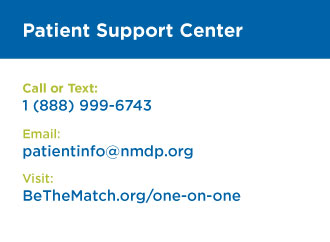You may feel ready to get back to some of the healthy habits you had before transplant, or start some new ones. Just like before your treatment, being physically active is one of the keys to feeling better and staying healthy.
Find a routine that keeps you motivated
Regular physical activity can help you feel better. Many transplant recipients say they have less pain, more energy and sleep better when they make physical activity part of their day.
“My recovery went a lot better due to exercise. Start as soon as you can and do whatever you can because there’s going to be a tremendous long-term benefit from it,” says David, a transplant recipient.
Talk to your doctor first
When you feel ready to start exercising again, talk to your doctor first and follow their recommendations. It’s best to start slow and gradually increase your activity level. For example, start with a small goal like walking down the street and back. Then, increase your distance as you feel able. Continue to increase your distance until you are able to walk at least 30 minutes a day.
“Once I started walking, I just felt better—physically, emotionally and mentally. It made a huge difference,” says Kay, a transplant recipient.
If walking isn’t enjoyable for you, try another aerobic activity, like riding a stationary bike, climbing stairs or dancing. Again, start with a small goal and add new goals as you are able. Once you’ve built up your strength, try to do aerobic activity for at least 30 minutes a day.
Don’t forget to do strength training and stretching, too. Start slowly. Even lifting soup cans at first can help increase your bone density and muscle strength and lower fatigue (tiredness). Gentle stretching and activities like yoga can help you increase your flexibility, and are good for your joints.
As you get stronger, you can slowly increase the intensity of your aerobic activity and strength training.
Is complementary or alternative medicine right for you?
During your treatment and recovery, you may have heard about complementary or alternative medicine (sometimes called CAM) and wondered if it is right for you as part of routine health lifestyle. The answer? It depends.
CAM practices that are generally safe include those that promote relaxation, well-being and movement such as:
- Meditation and prayer
- Guided imagery
- Massage
- Art and music therapy
- Yoga
- Tai chi
- Reiki
No matter which CAM practices you are considering, do your research and talk with your doctor before you start.
Not sure where to begin?
If you’d like some help getting started on an exercise routine, ask your doctor for a referral to physical therapy. Physical therapists can help you make an exercise program that’s safe for you and meets your needs. Check with your health insurance company because physical therapy costs might be covered by your policy.
No matter how you get started, find a routine that you enjoy and one that keeps you motivated.
Celebrate progress
During early recovery, your focus is likely on what is right in front of you, like getting to appointments, taking medicines, eating and resting. You may have had to go back to the hospital. You may feel discouraged.
Progress can sometimes be hard to see during recovery. Reflect on some of the milestones as you regain energy and strength for physical activity. Ask yourself, “What is one thing I did today that I could not do a month ago?”
For more information and support
- Contact the Be The Match Patient Support Center for information, resources and support.
- Call: 1 (888) 999-6743
- Email: patientinfo@nmdp.org

